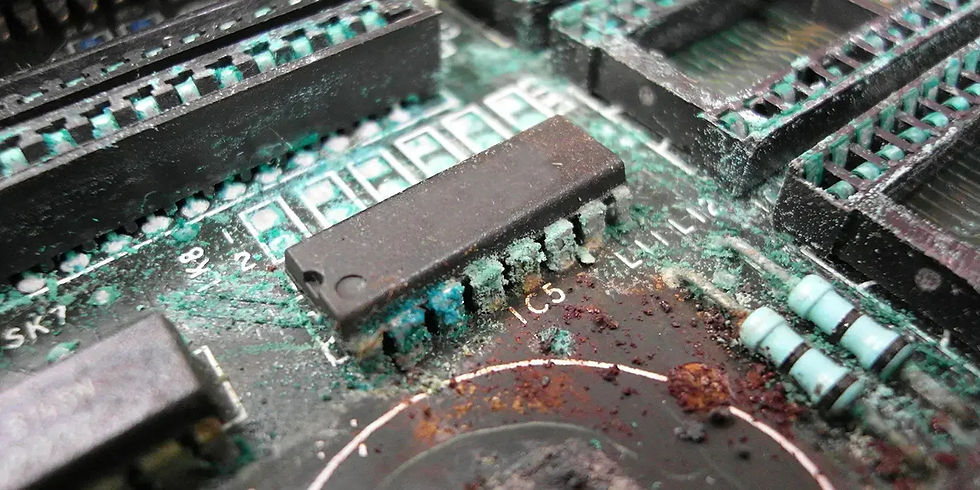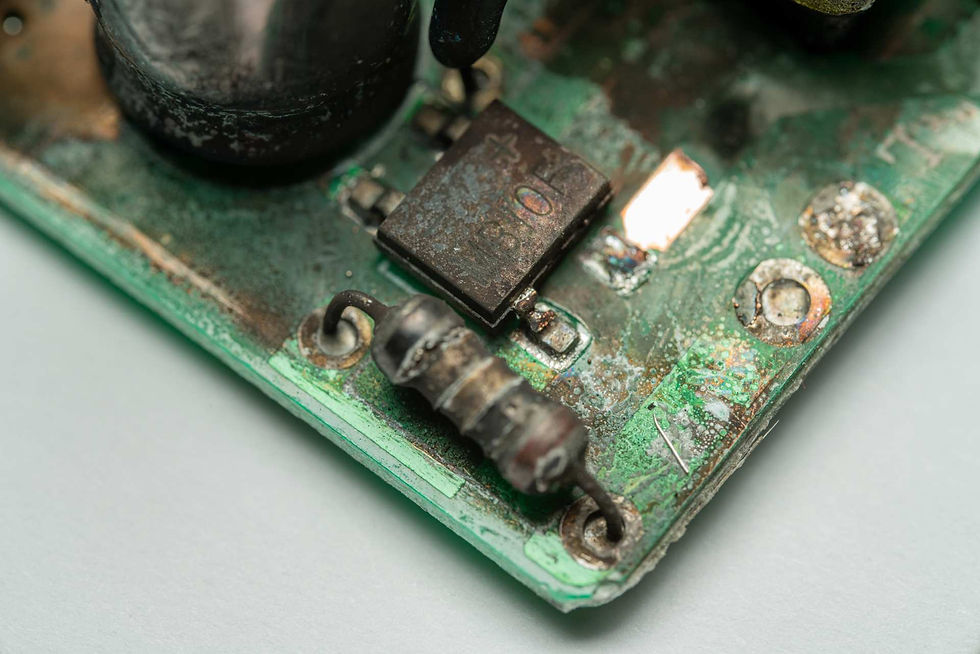Challenges in PCB Design for Harsh Environments: Solutions for Reliability
- TapRen Team

- May 14
- 7 min read
Updated: Jul 9

Abstract
This article focuses on designing PCBs that can withstand extreme conditions, such as high temperatures, moisture, and mechanical stress. It explores the materials, coatings, and design strategies that ensure reliability in harsh environments. You will learn about the key challenges faced in such designs and the innovative solutions that enhance the durability and performance of PCBs in demanding applications.
Introduction
Creating printed circuit boards (PCBs) for harsh environments presents unique challenges that call for creative fixes to guarantee reliability and efficiency. The integrity and operation of electronic components can be severely impacted by such conditions, which include high humidity, extreme temperatures, and exposure to corrosive substances. In order to avert malfunctions and preserve operational effectiveness, engineers need to handle heat control, mechanical stress, and moisture resistance. The implementation of innovative materials, resilient design techniques, and protective coatings is a crucial approach to overcoming these obstacles and ensuring PCB reliability under the harshest conditions.
Overcoming the Elements: Challenges and Solutions in Harsh-Environment PCB Design
Designing printed circuit boards (PCBs) for harsh environments demands a meticulous approach that tackles several critical challenges:
1. Moisture and Humidity:

Their influence can be compared to the relentless decay experienced by electronics in a humid rainforest or the catastrophic failure caused by saltwater immersion.
Destructive Mechanism: Moisture on the PCB surface can cause electrochemical dendrite growth, forming tree-like metal structures that bridge gaps between traces. This often leads to short circuits and device failure. Also, moisture catalyzes corrosion, gradually degrading metallic traces and components. Moisture poses a serious risk to PCB dependability because it raises electrical resistance, tampers with signal integrity, reduces performance, and ultimately leads to device failure.
Combat Approach: Combating moisture-induced failures in PCBs requires a multi-layered approach guided by international standards like IPC. First and foremost, it's critical to choose hydrophobic PCB base materials with low rates of moisture absorption, like laminates made of epoxy and specialty resin systems. Second, the application of conformal coatings creates a barrier that protects traces and components from impurities, dust, and moisture. These coatings, tailored for specific environments, enhance protection against abrasion and chemicals, ensuring reliable PCB.
2. Chemical Exposure:

While humidity and moisture are a major threat, chemical exposure is another danger that PCBs in industrial environments or medical equipment must contend with. On these sensitive circuits, solvents, fuels, and other harsh substances can cause havoc, functioning as a silent assassin that deteriorates performance and eventually causes failure.
Destructive Mechanism: The base materials of a PCB, typically epoxy resins and glass fiber reinforcements, can degrade when exposed to certain chemicals like acids, alkalis, and solvents, leading to resin softening, swelling, or cracking. This deteriorates the fire retardant qualities, posing a safety risk, and jeopardizes the structural integrity, leading to warping, delamination, and electrical failure. The PCB's delicate electronic components are also vulnerable to damage from chemicals, as exposure can cause corrosion, which raises electrical resistance and taints signal integrity. Harsh chemicals (sulfuric acid, hydrochloric acid, sodium hydroxide, and various organic solvents such as acetone and toluene) can cause cracking and delamination of component housings, exposing sensitive internals and compromising functionality, while solvents can dissolve or swell plastics in capacitors and other components, leading to permanent performance degradation.
Combat Approach: Strong PCB assemblies are protected from chemical attacks by international standards like IPC in Guidelines for Design, Selection and Application of Conformal Coatings. The first line of defense is to use high-performance laminates that are more chemically resistant than standard FR-4 laminates, and to choose components whose housings are made of chemically resistant plastics, such as high-performance thermoplastics (e.g., PEEK, PTFE). Chemical-resistant conformal coatings, such as silicone or fluoropolymer-based coatings, offer a barrier that shields PCB surfaces and components from harsh substances like acids, solvents, and corrosive gases, but they must be carefully selected based on individual chemical encounters.
3. Mechanical Stress:

Imagine the constant rumble of a jet engine or the jarring vibrations of a high-speed industrial robot. These mechanical stresses, including vibration, shock, and physical impacts, can be just as detrimental to PCBs as moisture or harsh chemicals.
Destructive Mechanism: The PCB substrate may break due to continuous strain from vibration or stress, jeopardizing structural integrity and interfering with electrical circuits. Repetitive stress can cause the solder joints holding electronic components to the PCB to break, which can result in electrical connection failures. For example, poor-quality solder joints in laptops used on commercial airplanes can crack due to constant vibration, resulting in display issues or system failures. In severe cases, impacts or high-gravity environments can dislodge mounted components from the PCB if solder joints fail or connectors are inadequate, such as a smartphone dropped onto a hard surface dislodging its camera module.
Combat Approach: To combat mechanical stress, choose strong and flexible PCB materials like high-performance laminates over standard FR-4. Secure anchoring is ensured by components with thick solder pads and sturdy leads. To distribute pressures and avoid stress development, incorporate support structures into your design, such as metal brackets or stiffeners. As seen in military electronics made for severe environments, use tight connectors to prevent component dislodgement from vibration or shock. PCB resilience is improved by this multifaceted approach in a range of applications.
4. High Temperatures:

Destructive Mechanism: The relentless heat in deserts, volcanic geothermal sites, or even within high-powered machinery can take a toll on PCBs. Extreme temperatures can degrade the base materials of the board itself, leading to warping or cracking. Additionally, solder joints can weaken or fail, and delicate electronic components may overheat and malfunction.
Combat Approach: To combat the fiery foe, high-temperature-resistant materials are the first line of defense. Polyimide films and ceramic substrates boast exceptional thermal properties, allowing them to withstand prolonged exposure to heat without succumbing to structural or electrical performance degradation.
Benefits of Reliable Harsh-Environment PCBs
Reliable PCBs designed for harsh environments offer several key advantages that enhance both product performance and longevity. Some of the advantages are:
1. Enhanced Product Lifespan:
Ensures reliable operation in extreme conditions.
Reduces maintenance costs and replacement needs.
Extends the overall lifespan of electronic devices.
2. Improved Performance:
Minimizes risk of malfunctions or failures due to environmental stressors.
Leads to consistent and dependable device performance.
3. Expanded Application Range:
Opens doors for innovative applications in challenging environments.
Supports industries like industrial automation, aerospace, and defense.
Enables electronics to perform reliably under extreme conditions.
4. Cost Efficiency:
Reduces downtime and associated costs from device failures.
Lowers the total cost of ownership by decreasing the frequency of replacements.
Provides long-term financial benefits by minimizing repair and maintenance expenses.
5. Increased Safety:
Ensures critical systems remain operational in hazardous conditions.
Enhances the safety of equipment used in industries like mining, oil and gas, and military applications.
Provides reliable performance in environments where failure can lead to significant risks.
Material Selection and Design Strategies for Durable PCBs in Harsh Environments
When it comes to PCBs venturing into the harsh battlegrounds of extreme temperatures, moisture, and mechanical stress, material selection and design strategies become the armor and tactics for ensuring their survival. Let's delve deeper into these crucial elements:
1. Material Selection: The Foundation of Durability

High-Temperature Warriors: Polyimide films and ceramic substrates are the ultimate heat shields. Their exceptional thermal stability allows them to withstand prolonged exposure to scorching deserts or high-powered machinery without succumbing to warping or performance degradation.
Moisture-Repelling Defenders: For humid rainforests or submerged applications, moisture resistance is paramount. Materials like Teflon (PTFE) and certain epoxy resins boast low moisture absorption rates, acting as a natural barrier against water ingress that could lead to dreaded short circuits and corrosion.
Mechanical Strength Champions: The constant rumble of industrial machinery or the jarring vibrations of a high-speed train demand robust materials. Fiberglass (FR4) and other composite materials provide the necessary strength and flexibility to endure mechanical stress, preventing cracks and fractures in the PCB or solder joints.
2. Protective Layers: Shielding the PCB from Environmental Hazards

Beyond the base materials, additional layers of defense are often crucial:
Conformal Coatings (The Invisible Armor): These coatings act as a suit of armor, safeguarding the PCB from moisture, dust, and even certain chemicals. Common types include acrylic, silicone, and urethane, offering varying degrees of protection depending on the specific environment.
Encapsulation (The Ultimate Bunker): For the most extreme conditions, complete encapsulation in a protective material like epoxy offers the ultimate shield. This encasement provides robust protection against moisture, vibration, and other threats.
Surface Treatments (The Finishing Touch): Anti-corrosive coatings and other surface treatments can further enhance the PCB's durability by creating an additional barrier against specific environmental hazards.
3. Design Strategies: The Art of PCB Resilience

Material selection and protective layers are just part of the equation. Here's how clever design tactics can further bolster PCB reliability:
Thermal Management: Heat sinks, thermal vias, and proper component spacing are crucial for efficient heat dissipation, preventing overheating and malfunctions in high-temperature environments.
Moisture Control: Proper sealing techniques and incorporating moisture barriers during design can significantly reduce the risk of moisture ingress, extending the lifespan of the PCB.
Mechanical Reinforcement: Robust mounting techniques and strategically placed support structures can minimize the impact of mechanical stress on the PCB, ensuring its structural integrity remains intact.
Testing for the Real World: Rigorous testing under simulated harsh conditions is essential. By mimicking the extreme environments the PCB may encounter, designers can identify and address potential weaknesses, ensuring the final product functions flawlessly in the field.
Key Takeaway
Designing PCBs for harsh environments requires a meticulous and comprehensive approach, encompassing the selection of materials, the application of protective coatings, and the implementation of robust design strategies. Understanding these challenges and applying the right solutions allows engineers to create reliable PCBs that withstand extreme conditions, ensuring the success of electronics in even the most demanding settings.
At TapRen, we specialize in delivering top-tier PCBs designed to excel in harsh environments. Our expertise in advanced materials and protective coatings, combined with our innovative design strategies, guarantees that our PCBs meet the highest standards of reliability and performance. Trust TapRen for your PCB needs and ensure your electronics thrive, no matter the conditions. Choose TapRen for solutions that conquer the elements and drive success.



Comments